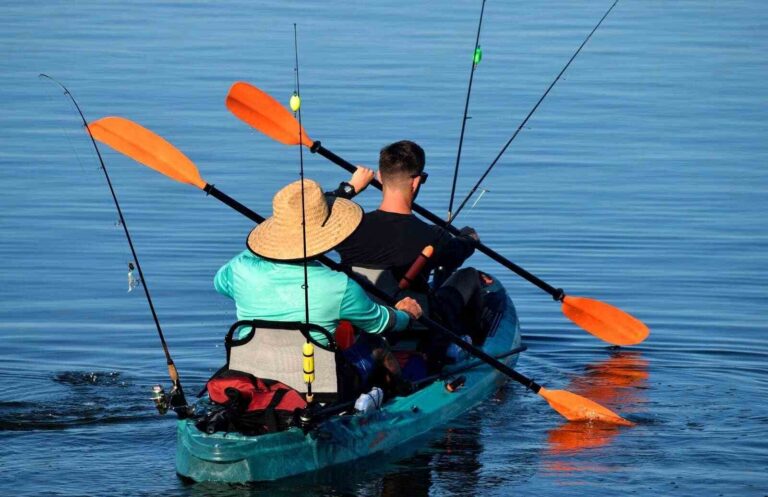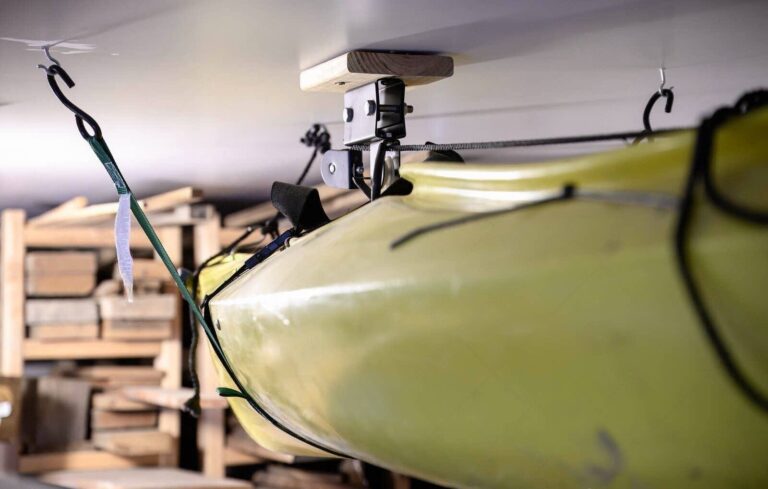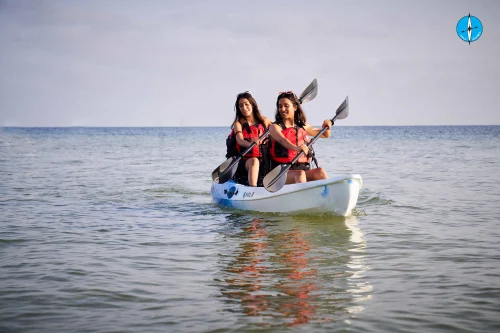How To Use A Trolling Motor On A Kayak?
Have you ever wished you could zip around the lake without paddling, or reach those far-off fishing spots without tiring out?
A trolling motor is the answer! It’s like adding a mini-engine to your kayak, letting you cruise effortlessly and explore more. This guide will show you how to choose one, install it, and use it like a pro.
Why a trolling motor? Well, it makes kayaking way more relaxing, helps you cover more water, and it’s fantastic for fishing (especially when trolling for those big catches).
How To Use A Trolling Motor On A Kayak?
Before we get too excited, there are some quick things to check. Depending on where you live, there might be rules about using motors on kayaks, so it’s best to look those up first.
Next, you need to pick the right motor for your kayak. There are different types, and the power of the motor needs to match the size of your boat. Don’t worry, we’ll explain all of that. We’ll also talk about batteries and how to get your motor hooked up safely.
Once your motor is set, it’s time to hit the water! You’ll learn how the controls work and get tips for handling your kayak with the motor in different conditions, like wind and waves.
Ready to make your kayaking adventures even better? Let’s get started!
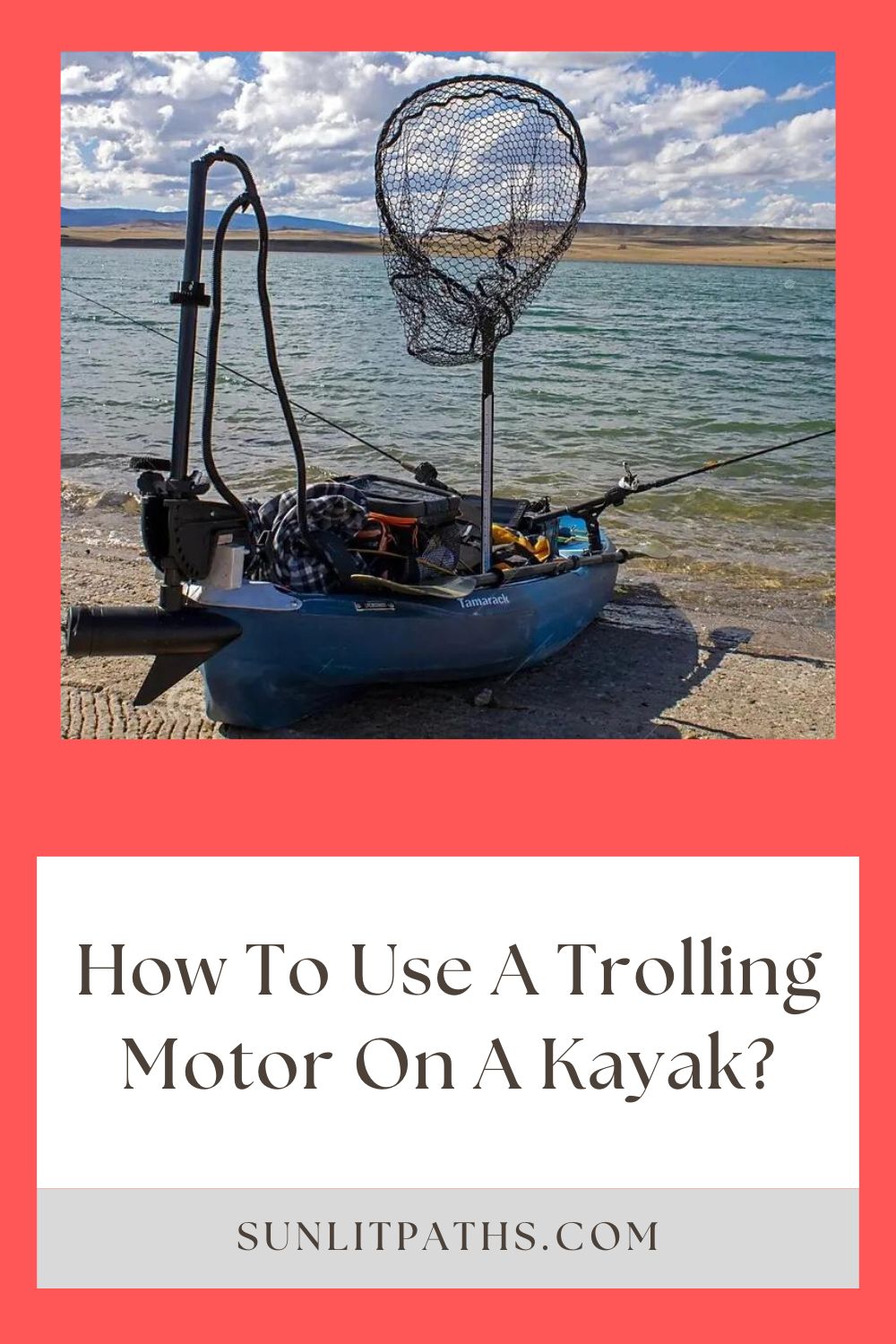
Why a Trolling Motor is Your New Best Friend
Imagine this. You’re gliding across the water without breaking a sweat, reaching those hidden fishing spots you could only dream of before. That’s the magic of a trolling motor! Here’s why it’s an awesome upgrade for your kayak:
- Kick back and relax: A trolling motor lets you chill out and enjoy the ride while your kayak does the work. No more tiring your arms out just to get to your favorite spot.
- Go the distance: With a motor, you can cover way more ground. Explore new areas of the lake, find those secret fishing holes, and spend more time doing what you love.
- Fishing game-changer: Love to troll for fish? A trolling motor keeps your kayak moving at the perfect speed, so you can focus on reeling in a big catch.
Ease of Movement
One of the key benefits of using a trolling motor on a kayak is the convenience it offers in terms of movement.
Traditional kayaking requires physical effort and paddling skills to navigate through the water.
With a trolling motor, you can effortlessly propel yourself forward, saving energy and reducing fatigue.
This allows you to cover more distance in less time, giving you the freedom to explore larger bodies of water or reach your favorite fishing spots more quickly.
Exploring New Waters
A motorized kayak opens up a world of possibilities for exploration.
By adding a trolling motor to your kayak, you can venture into new and remote waters that were previously inaccessible.
Explore hidden coves, mangroves, or shallow marshes that were off-limits to traditional paddlers.
Discover new fishing spots, observe wildlife in their natural habitats, and experience the thrill of exploring uncharted territories.
With a motorized kayak, the adventure never ends.
Trolling for Longer
If you’re an avid angler, a trolling motor can significantly enhance your fishing experience.
Trolling involves moving slowly through the water while dragging fishing lines behind your kayak.
By using a trolling motor, you can maintain the perfect trolling speed for extended periods, allowing you to cover more water and increase your chances of catching fish.
With a motorized kayak, you have the flexibility to fish different depths, change trolling speed, and experiment with various fishing techniques.
The advantages of trolling for fishing are amplified with the convenience and efficiency of a trolling motor.
Basics of Trolling Motors
In this section, we will provide a comprehensive overview of trolling motors, including how they work and the different components involved.
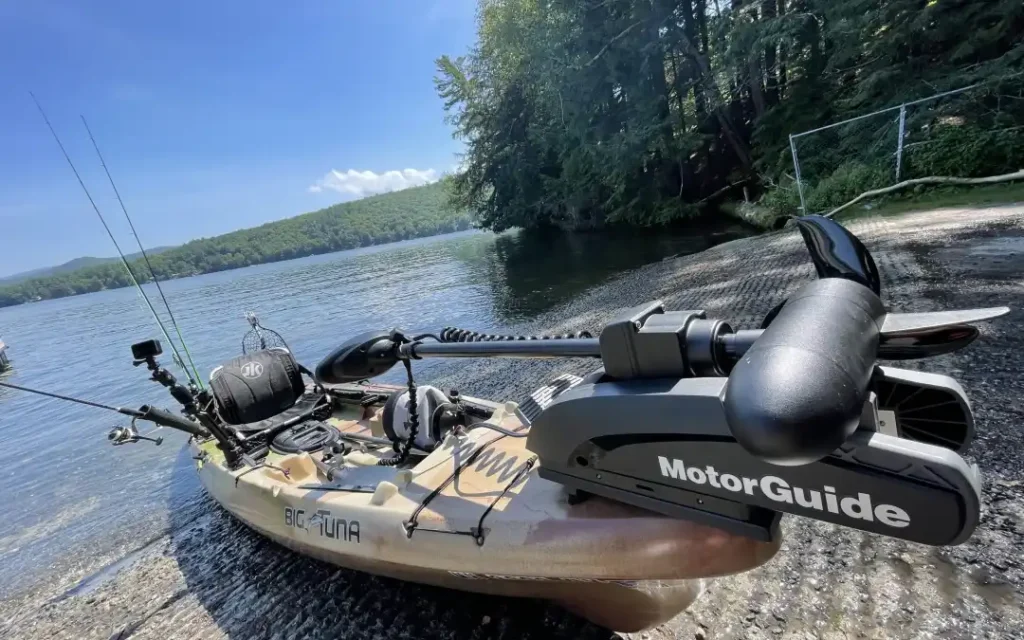
By understanding the basics, you will be well-equipped to make informed decisions when choosing and using a trolling motor for your kayak.
At the heart of a trolling motor is its motorized propulsion system, which consists of several key components:
- Propellers: Trolling motors are typically equipped with propellers that generate the necessary thrust to propel your kayak through the water. The size and number of blades can vary, impacting the motor’s efficiency and performance.
- Shafts: The shaft connects the motor housing to the propeller. It is responsible for transmitting power from the motor to the propeller, ensuring smooth and efficient operation. Shaft length is an important consideration, as it determines how deep the propeller will be submerged in the water.
- Controls: Trolling motors come with intuitive control mechanisms that allow you to adjust speed, direction, and other settings. Whether it’s a hand-operated tiller or a wireless remote control, the controls provide easy maneuverability and flexibility on the water.
- Power Source: Trolling motors are powered by batteries, which are usually mounted on your kayak. The type and capacity of the batteries will depend on the motor’s power requirements and your intended usage. It’s essential to choose the right batteries that provide sufficient power and reliable performance.
Understanding the basics of trolling motors, including their components and operation, will give you the foundation you need to explore the world of motorized kayaking effectively.
With this knowledge, you can confidently select and use a trolling motor that meets your needs and enhances your kayaking experience.
Is it Legal to Put a Trolling Motor on a Kayak?
State Regulations and Registration
Don’t Forget the Rules: The Legal Side of Motorized Kayaks
Before you start cruising with your new trolling motor, there’s some important stuff to check. Every state has its own rules about using motors on kayaks. Here’s what you need to know:
- Registration: Some states might treat your motorized kayak like a tiny boat, meaning you’ll need to register it and put those registration numbers on your kayak.
- Where you can go: You might not be able to use your motor everywhere. Some lakes and rivers have rules to protect wildlife or make sure everyone can enjoy the water.
- Power limits: In some places, there might be a limit to how strong a motor you can use.
The bottom line: Always check the rules for your state before you head out. You don’t want to get into trouble! It’s easy to find the information online – just search for “[your state] kayak motor regulations”.
Public vs Private Water
Another aspect to consider is the distinction between public and private waterways.
Where you plan to use your motorized kayak makes a big difference when it comes to the rules. Here’s the breakdown:
- Public Waters (lakes, rivers, etc.): Expect more regulations on these waterways. You might need special permits, registration, and there could be limits on where you can take your motorized kayak.
- Private Waters (someone’s pond, etc.): The owner of the land gets to set the rules. You’ll likely need their permission to use your motor, and they might have additional restrictions to follow.
The Smart Move: No matter where you want to kayak, always do your homework! Look up your state’s regulations and check for specific rules about the body of water you plan to use. This way, you’ll have a hassle-free and responsible time on the water.
Types of Motors for Kayaking
In this section, we will explore the different types of motors available for kayaking.
Whether you’re looking to enhance your fishing experience or simply enjoy the convenience of motorized movement, there are several options to consider.
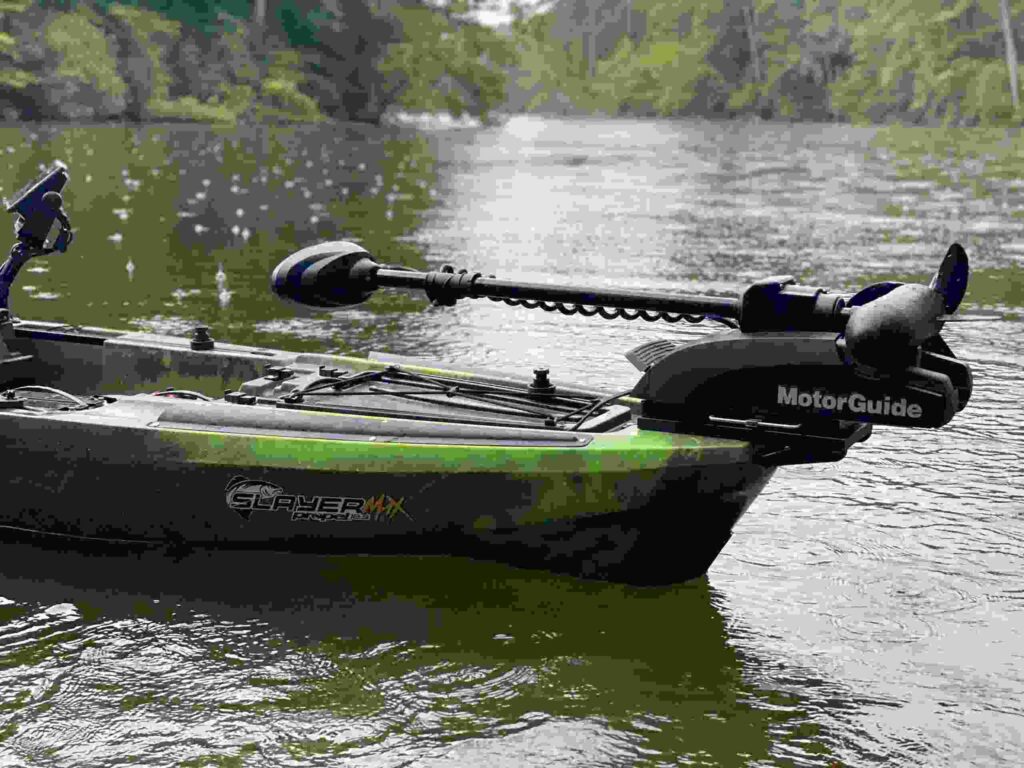
Trolling Motors Vs Electric Outboards
Choosing the right motor for your kayak comes down to what you’ll be using it for:
- Trolling motor: Think of this like cruise control for your kayak. It’s perfect for fishing or just chilling in calm waters. You get super-precise control, often with a foot pedal or remote, for those gentle movements.
- Electric outboard: This packs more of a punch! It’s the way to go if you need to cover longer distances, maybe fight against some current, or just want to zip around faster. These usually have a handle for steering, just like on a small boat.
Do you want precision or power? That’s the easiest way to decide between the two!
Electric Turbines
Want the latest and greatest in kayak motors? Check out electric turbines! These sleek motors are like a cool mix of super-efficient electric power with the zoom of a turbine. Here’s what makes them awesome:
- Stealth mode: They’re quiet, so you can sneak up on fish or just enjoy the peace of nature.
- Eco-friendly: No noisy gas engine here, just clean electric power.
- Power and distance: These babies are built for efficiency, giving you more range and speed on the water.
Choosing the Right Motor: It’s All About You
The best motor for your kayak depends on what you want to do:
- Precision fishing: Trolling motors are your jam, letting you control your speed and direction perfectly.
- Speed and distance: Electric outboards give you more oomph to cover ground or fight currents.
- Tech-lover: Electric turbines offer next-level performance and a super-cool factor.
Think about how you kayak, then choose the motor that fits your style!
Right Trolling Motor for Your Kayak
What Size Motor Do I Need?
When choosing a trolling motor for your kayak, it’s essential to assess your power needs to ensure optimal performance on the water.
The size of the motor depends on several factors, including the size and weight of your kayak, the type of water you’ll be navigating, and your desired speed.
To determine the right motor size, consider the following:
- The weight capacity of your kayak: Larger kayaks that can carry more weight may require a more powerful motor.
- Typical water conditions: If you’ll be kayaking in calm waters or slow-moving rivers, a smaller motor may suffice. However, if you’ll be tackling strong currents or choppy seas, a more powerful motor will be necessary.
- Your preferred speed: If you want to cruise at higher speeds, a larger motor with more power will be required.
Battery Compatibility and Efficiency
Another crucial factor to consider when selecting a trolling motor for your kayak is battery compatibility and efficiency.
Your trolling motor is only as good as the battery powering it. Here’s what you need to think about:
- What does your motor need? Some motors are picky and want a specific type of battery (like lead-acid or fancy lithium). Others are more flexible. Make sure the battery you choose is a match!
- How long will it last? You don’t want to run out of juice in the middle of the lake! Look for batteries that promise long runtimes and charge up quickly.
- Weight matters! A heavy battery can make your kayak feel sluggish. Find a balance between power and how much extra weight you’re willing to carry.
The right battery is the key to a great trolling motor experience. Do your research so you spend more time on the water and less time worrying about power.
Installing Your Trolling Motor
Choosing the Ideal Mounting Location
Step 1: Finding the Perfect Spot for Your Motor
Before you start drilling holes, take a minute to choose the best place to mount your trolling motor. Here’s what to look for:
- Usually at the back: The stern (that’s the rear of your kayak) is the most common spot. It’s out of the way and makes steering easier.
- Flat and strong: You want a stable surface so your motor won’t wobble around.
- Room to work: Make sure nothing is in the way (hatches, seats, etc.) where you’ll be attaching the motor.
Extra Things to Think About:
- Balance is key: You don’t want your kayak to feel lopsided with the motor on, so try to find a spot that helps keep things even.
- Watch the propeller: Make sure the motor won’t hit your rudder or anything else when it’s spinning.
- Check the instructions: Your kayak (or the motor) might have special notes about where it’s best to install things. Always read those first!
Attaching and Securing the Motor Properly
You’ve found the perfect spot, now let’s get that motor mounted!
- Line it up: Place the motor bracket where you chose, making sure it lines up perfectly with any holes or brackets on your kayak.
- Get those screws in: Use the screws that came with your motor or kayak. Tighten them up snugly, but don’t go overboard – you don’t want to crack anything!
- Motor time: Slide the motor onto the bracket. It should fit nicely without any wiggling. Some motors might also have clamps or locks – make sure those are tight too.
- The wiggle test: Give the whole thing a gentle shake. Everything should feel solid. If not, tighten things up or double-check that you’ve got it all attached correctly.
Important:
- Instructions are your friend! Every motor and kayak is a little different, so read the manuals that came with them. They’ll have the best tips.
- Safety first: A motor that falls off is no fun! Make sure everything is tight and secure before you hit the water.
Batteries and Management
In order to power your trolling motor effectively, it’s important to understand the different types of batteries available and how to manage them properly.
The choice between lead acid and lithium-ion batteries can significantly impact the performance and reliability of your kayak trolling motor.
The Difference Between Lead Acid and Lithium-ion Batteries
Lead acid batteries have been a popular choice for powering trolling motors due to their affordability and reliability.
They are heavy and require regular maintenance, including periodic adding of distilled water and checking the battery acid level.
While they have a lower upfront cost, lead acid batteries tend to have a shorter lifespan and overall capacity compared to lithium-ion batteries.
Lithium-ion batteries, on the other hand, offer several advantages.
They are lightweight, which is especially beneficial for kayak applications where weight is a crucial factor.
Lithium-ion batteries also have a longer lifespan, retain their charge better, and can provide more consistent power output over their cycle life.
However, they are more expensive than lead acid batteries.
When choosing between lead acid and lithium-ion batteries, consider factors such as budget, weight limitations, and desired battery lifespan.
If you prioritize cost-effectiveness and don’t mind the additional weight, lead acid batteries may be a suitable choice.
If weight and longevity are important to you, investing in lithium-ion batteries can offer significant benefits in terms of performance and overall experience.
When and How to Charge Your Batteries
Your trolling motor is only as good as its battery, so treat it right! Here’s how to get the most out of it:
- The manual is your guide: Different batteries need different care. Always check what the maker of your battery recommends.
- Get the right charger: Don’t just use any old charger! Make sure it’s made to work with the kind of battery you have.
- Safety first: Charge your battery somewhere with good airflow, and away from anything that could catch fire.
- Don’t bake or freeze it: Extreme heat or cold is bad news for batteries.
- Check the levels: Make a habit of checking the voltage on your battery to make sure it stays in a healthy range.
- Upgrade option: A special battery monitor gadget can make life easier, helping you keep track of the charge and protecting your investment.
A little care goes a long way! Follow these tips and your battery will keep you out on the water longer.
How to Use a Trolling Motor On A Kayak Effectively
Trolling Motor Handling and Steering Techniques
When using a trolling motor on a kayak, it’s essential to master handling and steering techniques to ensure smooth navigation and control.
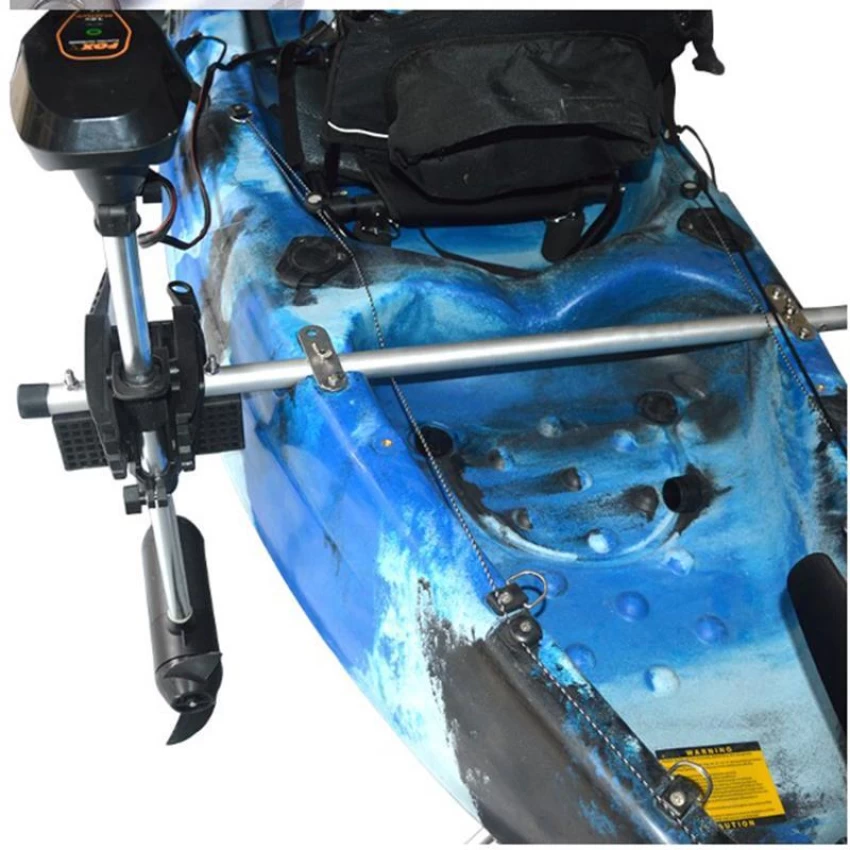
Here are some tips to help you effectively operate your trolling motor:
- Start by familiarizing yourself with the controls and functions of your trolling motor. Understand how to adjust the speed, steer, and reverse.
- Practice using the motor in calm and open waters before venturing into more challenging conditions.
- Use gradual motions when steering and avoid sudden jerks. This will help you maintain balance and stability on your kayak.
- When turning, apply gentle pressure on the motor’s controls to guide your kayak smoothly. Avoid oversteering, as it can cause instability.
- Experiment with different turning techniques, such as using a combination of paddle strokes and motor steering, to optimize maneuverability.
Control in Various Water Conditions
Don’t let choppy water or strong winds ruin your day! Here’s how to stay in control of your kayak:
- Match your speed to the weather: Slow and steady wins the race in rough water. Crank up the speed when it’s calm.
- Fight the flow: Pay attention to wind and currents. You’ll need to adjust your steering and power to keep on course.
- Paddle power: Even with a motor, your paddle is still your friend! Use it for extra control and quick turns.
- Eyes open: Look ahead and be ready to react to waves, other boats, or anything else that might come your way.
- Keep it clean: A bit of maintenance goes a long way. Check that propeller and make sure your motor is working at its best.
With a little practice, you’ll be navigating like a pro, no matter what the water throws at you!
Conclusion
Hopefully, you’re now convinced that a trolling motor can totally level up your kayaking game! Let’s recap why:
- Effortless Exploration: Cover more ground, reach those amazing spots, and do it all without getting worn out.
- Adventure awaits: For fishing, exploring, or just relaxing with a whole new view – a motor opens up tons of possibilities.
We’ve covered everything you need to know: the rules, picking the right motor, getting it installed, and even how to handle it in all kinds of conditions.
The bottom line: Whether you’ve been kayaking for years or are just getting started, a trolling motor is a fantastic upgrade. Think about the amazing adventures you want to have, follow the tips in this guide, and get ready to experience kayaking in a whole new way!
Frequently Asked Questions
Is it worth putting a trolling motor on a kayak?
Absolutely! Putting a trolling motor on a kayak can be a game-changer. It transforms your kayak into a hands-free fishing machine, helps you cover way more distance with less effort, and lets you explore areas you could only dream of reaching before.
If you value convenience, want to boost your fishing success, or simply love the idea of effortlessly cruising the water, a trolling motor is a worthwhile investment.
Just remember to factor in the additional cost and potential complexity, as well as any local regulations that might apply to motorized kayaks.
How fast will a kayak go with a trolling motor?
The speed of a kayak with a trolling motor depends on a few factors:
Thrust: Trolling motors are rated in pounds of thrust. Generally, more thrust means more speed potential.
Kayak size & weight: A heavier kayak or one with more drag won’t go as fast as a lighter, streamlined model, even with the same motor.
Water conditions: Wind, waves, and current can significantly impact your speed.
On average, expect a top speed of around 4-6 miles per hour in calm conditions with a typical trolling motor on a standard kayak.
Of course, some setups might be slightly slower or faster depending on the factors mentioned above.
What speed should I troll with a kayak?
The ideal trolling speed for a kayak depends on the type of fish you’re targeting, but here’s a general guide:
General rule of thumb: Most kayak anglers find success trolling between 1.5 and 2.5 mph.
Species-specific: Here are some common recommendations:Walleye: 1-2 mph
Bass: 1.5-3 mph
Salmon: 2-3 mph
Trout: 1-2 mph
Conditions matter: Wind, current, and even water depth can influence the ideal trolling speed.
Tips:
Start slow and adjust: Begin at the lower end of the typical range and gradually increase your speed until you start getting bites.
Experiment: Don’t be afraid to change your speed. Fish can be finicky, and sometimes a slight change makes the difference.
Use a GPS: If you have a GPS unit, it can help you maintain a consistent speed and make the most of your trolling efforts.
What size trolling motor do I need for a kayak?
The best trolling motor for your kayak depends on a few things:
Kayak size & weight: A big, heavy kayak needs a stronger motor to move it efficiently. Smaller kayaks can get by with less power.
Where you’ll use it: Calm lakes? You don’t need as much power as someone fighting against river currents.
Rule of thumb: For most kayaks, a motor with 30-55 lbs of thrust is a good starting point.
Bottom line: Matching the motor to your kayak is key! You want enough power to move easily, but not so much that you’re wasting battery life.
Let me know if you want help figuring out the perfect size motor for your specific kayak!
Do trolling motors scare fish?
Trolling motors are way quieter than gas-powered outboards, which is a big plus for anglers who don’t want to scare the fish away.
However, some fish, especially in areas with lots of fishing pressure, might still be a bit skittish around any kind of motor noise.
Here’s how to minimize the impact:
Slow and steady: Ease into fishing spots and keep your motor at a consistent speed. Sudden changes are more likely to spook fish.
Be sneaky: Good fishing techniques always help! Cast gently, be aware of what’s around you, and try to blend in with your environment.
The upside: Even if a few fish are cautious, a trolling motor still lets you cover way more water and find those less-pressured spots where the fish are biting!
How long will kayak trolling motor last?
A good quality trolling motor isn’t cheap, so you want to get the most out of it! How long it lasts depends on a few things:
Quality matters: A well-made motor will naturally last longer.
Treat it right: Taking care of your motor is key! Think regular cleaning, proper storage, and not abusing it on the water.
Saltwater vs. fresh: Saltwater is tougher on motors, so they’ll need extra TLC if that’s where you fish.
Follow the instructions that came with your motor, do the basic maintenance, and avoid pushing it too hard. With a little effort, you can have a motor that keeps you out on the water for years and years.
Can you put a trolling motor on a regular kayak?
In most cases, yes! Lots of kayaks are designed to easily take a trolling motor, and there are even special kits to help you do it.
If you’re handy, you can find ways to add a motor to almost any kayak, as long as the motor isn’t too heavy for your boat.
Things to keep in mind:
Check the instructions: Your kayak might have specific recommendations for motor size.
Mounting matters: Make sure the motor is attached really securely. You don’t want it falling off in the middle of the lake!
Weight limits: Every kayak can only carry so much. Make sure the weight of the motor, battery, and you doesn’t put you over the limit.
How many hours can a trolling motor run?
Unfortunately, there’s no single answer about how long a trolling motor battery will last. It depends on:
Battery size: Bigger batteries hold more power, so they’ll last longer.
How fast you go: Faster speeds drain the battery quicker.
How efficient your motor is: Some motors are better at squeezing every bit of power out of the battery.
On average, expect around 5-6 hours of runtime with a typical setup. But, it could easily be less if you’re pushing a heavy kayak or maxing out the speed.
Check the battery level: Don’t get stranded in the middle of the lake!
Bring a backup: Either a spare battery or a portable charger can be a lifesaver.
Don’t let a dead battery ruin your day – with a little preparation, you can stay out on the water as long as you want!
How far can a trolling motor take a kayak?
The distance you can travel on a single battery charge depends on a few things:
Battery power: A big battery means more miles.
Speed demons need more juice: Going fast uses up your battery more quickly.
Kayak weight: A lighter kayak will glide further with the same amount of power.
Fighting the elements: Wind and current will drain your battery faster.
On average, expect somewhere between 10-20 miles on a typical setup. But it’s easy to end up with more or less range depending on the factors above.
The takeaway: Plan ahead! Think about how far you want to travel and manage your speed accordingly so you don’t end up paddling home.
Are trolling motors water proof?
Trolling motors are built tough to handle some water – think splashes, rain, and those accidental dips. But they’re not designed to live underwater!
Here’s the deal:
Prolonged soaking is bad: Heavy rain, sinking your kayak, etc., can damage the motor.
Saltwater is extra harsh: Always rinse your motor off after using it in the ocean.
Follow the instructions: Your motor’s manual will have specific care tips.
A little TLC goes a long way: Proper storage (think a waterproof cover) helps protect your investment.
Bottom line: Trolling motors are perfect for normal kayaking conditions. Just don’t try to use them for deep-sea exploration!

